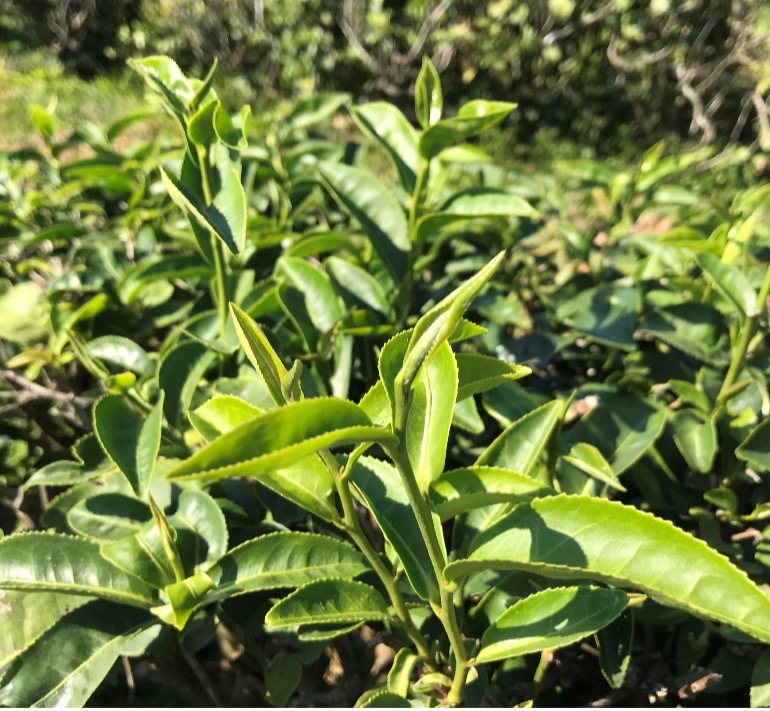


“ชาเขียว” กับการใช้ประโยชน์เพื่อรักษาสุขภาพในช่องปาก
อัพเดทล่าสุด 1 year, 10 months ที่แล้ว
สำนักงานข้อมูลสมุนไพร
คณะเภสัชศาสตร์ มหาวิทยาลัยมหิดล
ชาเขียว (green
tea) คือใบชา
[Camellia
sinensis
(L.) Kuntze]
ที่ไม่ผ่านกระบวนการหมัก ทำให้ใบชายังคงมีสีเขียว น้ำชามีสีเขียวหรือเหลืองอ่อน
กลิ่นหอม รสชาตินุ่มนวล
โดยในการะบวนการผลิตจะทำการเก็บใบชาส่วนยอดอ่อนที่ม้วนตัวอยู่ปลายกิ่งและเป็นใบอ่อน
2 ใบแรกเท่านั้น และทำอย่างระมัดระวังเพื่อไม่ให้ใบชาช้ำ หลังจากเก็บใบชาแล้วต้องนำส่งโรงงานอย่างรวดเร็วเพื่อเข้าสู่กระบวนการผลิตซึ่งประกอบด้วย
3 ขั้นตอนหลักคือ การให้ความร้อนโดยใช้ไอน้ำหรือคั่วในกระทะ การนวดคลึง
และการอบแห้ง (1)
สารออกฤทธิ์สำคัญที่พบในใบชาเขียวคือ สารโพลีฟีนอล (polyphenols) ที่เป็นสารกลุ่ม catechins ประกอบด้วยสารหลักที่พบได้มาก 4 ชนิดคือ (-)-epicatechin (EC), (-)-epicatechin-3-gallate (ECG), (-)-epigallocatechin (EGC) และ (-)-epigallocatechin-3-gallate (EGCG) (2) ซึ่งมีรายงานการวิจัยเกี่ยวกับฤทธิ์ทางเภสัชวิทยาของสารดังกล่าวที่เป็นประโยชน์ต่อร่างกายเป็นจำนวนมาก รวมถึงประโยชน์ต่อการดูแลรักษาสุขภาพช่องปาก โดยพบว่า สารสกัดน้ำจากชาเขียวหรือน้ำยาบ้วนปากที่ประกอบด้วยสารสำคัญจากชาเขียว (สารประกอบฟีนอลิก 0.5%) มีฤทธิ์ยับยั้งเชื้อแบคทีเรียก่อโรคในช่องปาก (Streptococcus mutans และ Lactobacillus spp.) (3-5) และยับยั้งการเกิดคราบจุลินทรีย์ (antiplaque) ซึ่งเป็นสาเหตุหนึ่งของโรคฟันผุ (6-8) โดยมีประสิทธิภาพใกล้เคียงกับน้ำยาบ้วนปากทางการค้าที่ประกอบด้วยสาร chlorhexidine และ sodium fluoride (9-12) นอกจากนี้ ยังพบการศึกษาถึงการใช้ผลิตภัณฑ์ในช่องปากชนิดต่างๆ เช่น ยาสีฟัน เจลป้ายเหงือก และน้ำยาบ้วนปาก ซึ่งมีสารสกัดจากชาเขียวเป็นส่วนประกอบ พบว่ามีฤทธิ์ที่เป็นประโยชน์ในการดูแลรักษาช่องปากได้แก่ ฤทธิ์ป้องกันการสึกกร่อนและรักษาผิวเคลือบฟัน (13-15) ฤทธิ์ลดความเป็นกรดในช่องปาก (16-17) ฤทธิ์ต้านการอักเสบและบรรเทาอาการของโรคปริทันต์อักเสบ (18-20) และฤทธิ์แก้ปวดในผู้ป่วยโรคทางทันตกรรม (21-22) เป็นต้น
จากข้อมูลแสดงให้เห็นว่า ชาเขียวนับเป็นอีกหนึ่งทางเลือกที่สามารถใช้ประโยชน์เพื่อดูแลรักษาสุขภาพช่องปากได้ โดยมีวิธีการเตรียมอย่างง่ายซึ่งแนะนำเพื่อใช้ในชีวิตประจำวันได้ดังต่อไปนี้
- สารสกัดน้ำชาเขียว 2% (ชาเขียว 2 ก. ซึ่งบรรจุอยู่ในถุงชา แช่ในน้ำอุ่น 100 มล. นาน 5 นาที) ใช้กลั้วปากวันละ 2 ครั้ง (ระหว่างเวลา 10.00 น. – 23.00 น.) แต่ละครั้งใช้เวลานานประมาณ 1 นาที เป็นระยะเวลา 1 เดือน มีผลลดความเป็นกรดของน้ำลายซึ่งเป็นสาเหตุหนึ่งของการเกิดฟันผุ (16-17)
- สารสกัดน้ำชาเขียว (ใบชาเขียว 1 ก. ชงในน้ำเดือด 100 มล. นาน 20 นาที และกรองแยกเอาเฉพาะส่วนน้ำ) ใช้กลั้วปากวันละ 2 ครั้ง (หลังมื้ออาหารเช้าและก่อนนอน) เป็นระยะเวลา 4 สัปดาห์ ช่วยปริมาณเชื้อ S. mutans ในช่องปาก ซึ่งเป็นสาเหตุหนึ่งของโรคฟันผุได้ (4)
- สารสกัดน้ำชาเขียว (ใบชาโขลกละเอียด 1.6 ก. ละลายในน้ำเดือดอุณหภูมิ 100ºC ปริมาตร 40 มล. นาน 3 นาที) ใช้กลั้วปากวันละ 3 ครั้ง (หลังอาหารมื้อเช้า เที่ยง และก่อนนอน) แต่ละครั้งใช้เวลานานประมาณ 1 นาที เป็นระยะเวลา 7 วัน มีผลช่วยลดค่า CFU ของเชื้อ S. mutans และ Lactobacillus spp. ในช่องปากได้ (3)
ข้อควรระวัง
แม้ว่าจากข้อมูลงานวิจัยที่กล่าวมาข้างต้นจะชี้ให้เห็นถึงประโยชน์ของชาเขียวต่อสุขภาพในช่องปาก แต่ก็มีข้อควรระวังในการบริโภคเนื่องจากการสะสมฟลูออไรด์ในใบชา ซึ่งพบข้อมูลว่าการที่เด็กเล็กได้รับฟลูออไรด์ในปริมาณที่สูงมากเกินไปอาจส่งผลเสียต่อสุขภาพฟันได้เช่นกัน โดยเด็ก (อายุไม่เกิน 7 ปี) ที่ดื่มน้ำที่มีปริมาณฟลูออไรด์ 2 ppm จะมีความเสี่ยงต่อการเกิดโรคฟันตกกระ (dental fluorosis) และเด็กที่ดื่มน้ำมีปริมาณฟลูออไรด์ 4 ppm มีโอกาสในการเกิดการสร้างเคลือบฟันที่ไม่สมบูรณ์จนเป็นเหตุให้มีอัตราการเกิดโรคฟันผุสูงกว่าการดื่มน้ำที่ไม่มีฟลูออไรด์เลย ดังนั้นการพิจารณาแหล่งให้ฟลูออไรด์เสริมกับเด็กต้องพิจารณาและตรวจสอบอย่างเข้มงวด และไม่ควรดื่มเครื่องดื่มชาเขียวสำเร็จรูปตามท้องตลาดที่มีปริมาณฟลูออไรด์มากกว่า 1 ppm เพื่อป้องกันไม่ให้ร่างกายได้รับฟลูออไรด์มากเกินไป (23)
เอกสารอ้างอิง
1. ดาเรศ บันเทิงจิตร. ชาเขียว. วารสารกรมวิทยาศาสตร์บริการ. 2547;52(164):10-4.
2. Kochman J, Jakubczyk K, Antoniewicz J, Mruk H, Janda K. Health benefits and chemical composition of matcha green tea: a review. Molecules. 2020;26(1):85.
3. Ferrazzano GF, Roberto L, Amato I, Cantile T, Sangianantoni G, Ingenito A. Antimicrobial properties of green tea extract against cariogenic microflora: an in vivo study. J Med Food. 2011;14(9):907-11.
4. Salama MT, Alsughier ZA. Effect of green tea extract mouthwash on salivary Streptococcus mutans counts in a group of preschool children: an in vivo study. Int J Clin Pediatr Dent. 2019;12(2):133-8.
5. Ahmadi MH, Sarrami L, Yegdaneh A, Homayoni A, Bakhtiyari Z, Danaeifar N, Akhlaghi N. Comparative evaluation of efficacy of green tea mouth rinse and green tea gel on the salivary Streptococcus mutans and Lactobacillus colony count in 12-18-year-old teenagers: a randomized clinical trial. Contemp Clin Dent. 2019;10(1):81-5.
6. Sarin S, Marya C, Nagpal R, Oberoi SS, Rekhi A. Preliminary clinical evidence of the antiplaque, antigingivitis efficacy of a mouthwash containing 2% green tea - a randomised clinical trial. Oral Health Prev Dent. 2015;13(3):197-203.
7. Kaur H, Jain S, Kaur A. Comparative evaluation of the antiplaque effectiveness of green tea catechin mouthwash with chlorhexidine gluconate. J Indian Soc Periodontol. 2014;18(2):178-82.
8. Radafshar G, Ghotbizadeh M, Saadat F, Mirfarhadi N. Effects of green tea (Camellia sinensis) mouthwash containing 1% tannin on dental plaque and chronic gingivitis: a double-blinded, randomized, controlled trial. J Investig Clin Dent. 2017;8(1):1-7.
9. Thomas A, Thakur SR, Shetty SB. Anti-microbial efficacy of green tea and chlorhexidine mouth rinses against Streptococcus mutans, Lactobacilli spp. and Candida albicans in children with severe early childhood caries: a randomized clinical study. J Indian Soc Pedod Prev Dent. 2016;34(1):65-70.
10. Kaur H, Jain S, Kaur A. Comparative evaluation of the antiplaque effectiveness of green tea catechin mouthwash with chlorhexidine gluconate. J Indian Soc Periodontol. 2014;18(2):178-82.
11. Radafshar G, Ghotbizadeh M, Saadat F, Mirfarhadi N. Effects of green tea (Camellia sinensis) mouthwash containing 1% tannin on dental plaque and chronic gingivitis: a double-blinded, randomized, controlled trial. J Investig Clin Dent. 2017;8(1):1-7.
12. Hambire CU, Jawade R, Patil A, Wani VR, Kulkarni AA, Nehete PB. Comparing the antiplaque efficacy of 0.5% Camellia sinensis extract, 0.05% sodium fluoride, and 0.2% chlorhexidine gluconate mouthwash in children. J Int Soc Prev Community Dent. 2015;5(3):218-26.
13. Magalhães AC, Wiegand A, Rios D, Hannas A, Attin T, Buzalaf MA. Chlorhexidine and green tea extract reduce dentin erosion and abrasion in situ. J Dent. 2009;37(12):994-8.
14. Kato MT, Magalhães AC, Rios D, Hannas AR, Attin T, Buzalaf MA. Protective effect of green tea on dentin erosion and abrasion. J Appl Oral Sci. 2009;17(6):560-4.
15. Suyama E, Tamura T, Ozawa T, Suzuki A, Iijima Y, Saito T. Remineralization and acid resistance of enamel lesions after chewing gum containing fluoride extracted from green tea. Aust Dent J. 2011;56(4):394-400.
16. Manikandan S, Behera S, Karthikeyan R, Niranjana A, Bharathan R, Mohammed OFB. Effect of green tea extract mouthrinse and probiotic mouthrinse on salivary pH in a group of schoolchildren: an in nivo study. J Pharm Bioallied Sci. 2020;12(Suppl 1):S404-9.
17. Kamalaksharappa SK, Rai R, Babaji P, Pradeep MC. Efficacy of probiotic and green tea mouthrinse on salivary pH. J Indian Soc Pedod Prev Dent. 2018;36(3):279-82.
18. Chava VK, Vedula BD. Thermo-reversible green tea catechin gel for local application in chronic periodontitis: a 4-week clinical trial. J Periodontol. 2013;84(9):1290- 6.
19. Mustafa SQ, Baban DA. Efficacy of green tea mouth wash as an adjunct to non-surgical periodontal treatment in patients with chronic periodontitis. EDJ. 2019;2(1):180-7.
20. Hrishi TS, Kundapur PP, Naha A, Thomas BS, Kamath S, Bhat GS. Effect of adjunctive use of green tea dentifrice in periodontitis patients - a randomized controlled pilot study. Int J Dent Hyg. 2016;14(3):178-83.
21. Eshghpour M, Mortazavi H, Rezaei NM, Nejat A. Effectiveness of green tea mouthwash in postoperative pain control following surgical removal of impacted third molars: double blind randomized clinical trial. Daru. 2013;21(1):59.
22. Shahakbari R, Eshghpour M, Rajaei A, Rezaei NM, Golfakhrabadi P, Nejat A. Effectiveness of green tea mouthwash in comparison to chlorhexidine mouthwash in patients with acute pericoronitis: a randomized clinical trial. Int J Oral Maxillofac Surg. 2014;43(11):1394-8.
23. ยุทธนา ปัญญางาม, พรศรี ปฎิมานุเกษม, ระวีวรรณ ปัญญางาม. ปริมาณฟลูออไรด์ในเครื่องดื่มชาเขียวสำเร็จรูปที่มีจำหน่ายในกรุงเทพมหานคร. วิทยาสารทันตสาธารณสุข. 2548;10(1-2):61-72.
